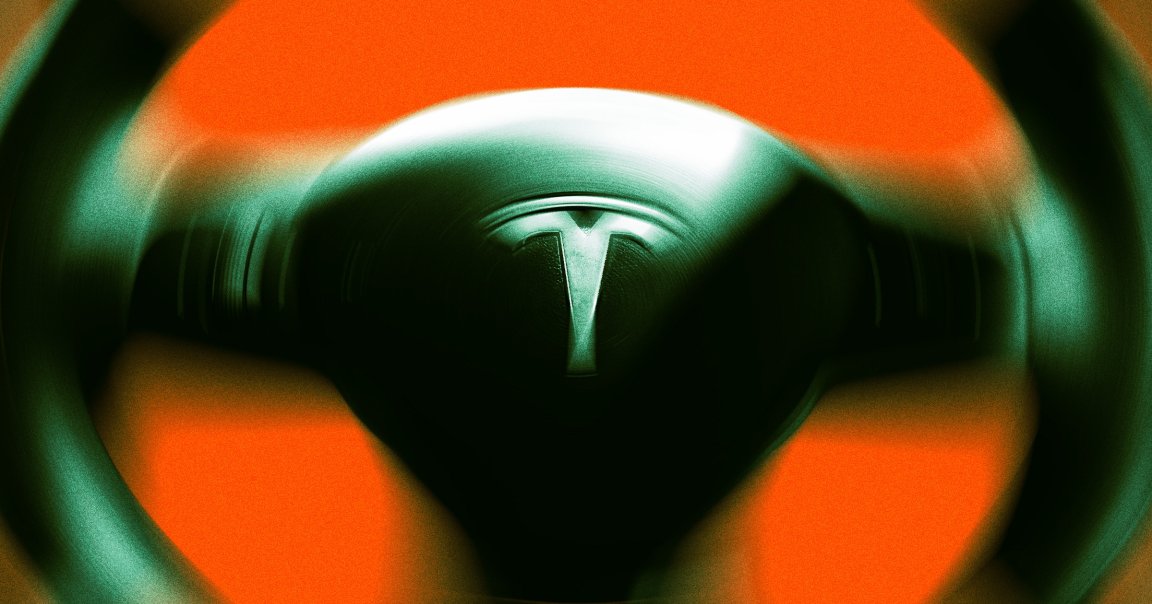
Tesla’s Robotaxi service is finally, actually here. And for the most part, the launch, which took place this weekend, has been pretty uneventful. A spate of Tesla “influencers” have already uploaded videos of their first rides depicting the driverless cabs — though not supervisor-less, as each one comes with a human “safety monitor” silently riding shotgun — roaming the streets of Austin, Texas. Nothing to write home about.
Except for at least one genuinely bizarre incident. In a video uploaded to YouTube by Tesla Daily, the Model Y our cameraman is riding in suddenly starts jerking the steering wheel dangerously back and forth while driving through the middle of a large intersection, eliciting a loud honk from the car behind it.
The Tesla then quickly corrects itself — only to commit another blunder. Driving onward, the robotaxi blatantly crosses the street’s solid double yellow lines to sneak into a left turn lane, which was blocked by cars in the other lanes. There was no oncoming traffic, and it’d be a mostly harmless infraction for a human driver to make. But it’s eyebrow-raising to see this kind of behavior performed by a machine that’s supposed to prioritize safety above all else. (“We are being super paranoid about safety,” Elon Musk said in a tweet in the weeks leading up to the launch.)
It’s not certain why the steering freaked out. There’s no oncoming traffic to get in the way. But on the dashboard, we can see the blue line showing the robotaxi’s projected route flipping left and right in tandem with the vehicle’s jerking motions, with the Tesla seemingly hesitating on which way to go.
That suggests some sort of navigation issue (which is the uploader’s diagnosis, too.) In fact, it looks like the Tesla may have gotten into a left-turn-only lane one intersection too early, in preparation to get into the turn lane ahead — the one where the Tesla crossed the double yellow lines to reach — causing it to get stuck in between two directions.
Clearly there’s some fine-tuning to be done. The launch is limited to a small pool of customers who were given exclusive access to the accompanying app, with only 10-20 autonomous “Robotaxi”-branded Model Y cars in operation. Each ride costs a flat fee of $4.20 — Musk’s idea of a joke.
The presence of the “safety monitors,” despite Musk’s promise that the service would be unsupervised, serve as another reminder of technology’s questionable capabilities. As TechCrunch noted, Tesla’s robotaxi competitor Waymo tested its own vehicles by having human supervisors both behind the wheel and sitting shotgun. And that was done, crucially, during the testing phase, until it was deemed safe enough to remove them. Tesla has jumped straight into commercial operations. Most of all, it’s not well-defined what the supervisors are supposed to do — or how they’re supposed to intervene — when they’re sitting in the passenger seat and not the driver’s.
What’s also worth noting is that the Robotaxis are limited to a “geofenced” and extensively mapped part of Austin. That area turned out to be pretty small. What we’re seeing right now is the Tesla cabs operating in the best possible conditions, in which they don’t have to stray an inch outside the veritable video game level that the engineers created for them. Any little mistake should be scrutinized in light of that.
Is it a good sign that the robotaxis are already getting into the wrong lane, jerking back and forth, and illegally crossing solid double yellow lines? It’s all the more concerning given that Musk is promising the robotaxi service will scale at an absurd rate: just a month ago, he estimated that over 1,000 Tesla robotaxis will be roaming Austin “within a few months” of the launch, and a still more improbable one million of them would be navigating American roads by the end of 2026. There won’t be the crutch of “geofencing” to help the robotaxis then.
More on Tesla: Tesla Stock Plummets as Company Abruptly Halts Production of Cybertruck and Model Y